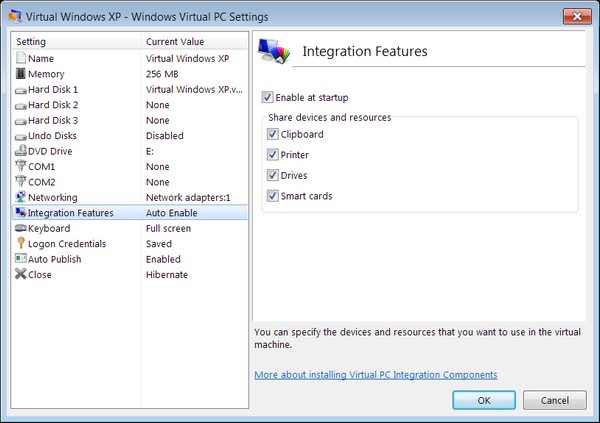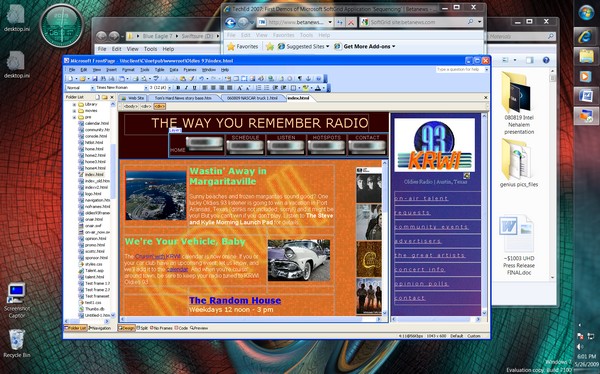By Scott M. Fulton, III, Betanews


In some ways, Steve Ballmer is proving to be a more capable Microsoft CEO than Bill Gates, especially recently. Whereas Gates' strategies have typically been associated with playing unfair, rewriting the rules, and being blatantly defiant about it in the process, Ballmer's strategy of taking away the argument -- eliminating the appearance of advantage and then still winning -- has been more effective, and more difficult to combat in both the marketplace and the courtroom.
Nowhere does the "Playing Too Fair" strategy make a bigger display of itself in Microsoft's favor than in its latest permutation of virtualization technology -- a move that many individuals (myself included) directly suggested the company should do, and the company then did. Since 2004, Microsoft has offered a no-cost way for users to run Windows XP in a kind of hosted envelope, one which users were delighted to discover worked fairly well in Windows Vista. But it didn't offer any real advantages -- to use a program that relied on XP, you had to work within that envelope, using networking tools to associate two machines running on the same CPU.
Meanwhile, business users were being offered an ingenious little tool (ingenious enough for some folks to infer automatically it wasn't Microsoft that created it) that extended the virtualization envelope to the main, physical desktop. SoftGrid let users run an application on a computer as though it were installed on that computer, without it actually being there -- it could be on a virtual machine, or on a virtual or physical system someplace else in the network. Users would not have to be informed of the difference.
This is where I said, "You should build that feature into the client OS, so that if a program required XP, it would still run without the error." And Microsoft's folks responded, "Yea, that's a good idea." And where I thought it was filed away with all the other "good ideas" we've had over the years.
But this one has come to fruition. It's not a completely integrated way of running XP alongside Win7, but if you think about it, perhaps it shouldn't be. Years ago prior to Vista, Microsoft's own staff members disputed with one another whether PowerShell should be part of the system. Its initial compromise -- distributing it as a free download, but not as part of the Vista package -- enabled spokespersons to continue saying PowerShell wasn't really a part of Vista. By that same logic, XP Mode is not a part of Windows 7. But there's no dispute going on among spokespersons today; XP Mode is being described as "a feature of Windows 7 Professional, Ultimate, Enterprise." That may mean it's downloadable separately for free, although the company is saying that it may come pre-installed by OEMs on new PCs.
XP Mode, at first glance, looks like a slightly enhanced version of Virtual PC 2007 hosting an XP VM, dressed in the hue that Microsoft's Mark Russinovich has lovingly dubbed "Teletubbies Blue." Lurking beneath the surface here, however, is a vastly enhanced version of what VPC called "Virtual Machine Additions." With "Integration Features," there's a new, if limited, channel of communication between the Win7 host and the XP guest. One of the topics of discussion between these two parties is the changes that are made to XP's copy of the System Registry.
Those changes are often made on account of programs being installed, so the new Windows Virtual PC hypervisor monitors for those changes and takes notes. It does this so it can add whatever programs you installed in the XP environment, in the Win7 start menu as well, along with the necessary commands to trigger running those programs through the VM.

There's no instructions in the Windows 7 Release Candidate as yet for how to do this integration (documentation is often the last feature to be added to any software) but for once, that's not a big problem. It's very conceivable that any novice user can be instructed in this process, because at long last, Microsoft has avoided the usual tack of "wizardizing" its tasks in multiple-step, tunnel-like processes that draw out the simplest of functions into nightmarish, elongated marathon sessions. Instead, the company decided that a simple and direct, if not obvious, approach was warranted, and here it is: To install an XP program into your Windows 7 Start Menu, install it in the XP virtual machine first, and then exit the XP VM. Wait about 20 seconds.
 During that time, Windows Virtual PC processes all those notes it was taking, and creates duplicate entries for newly installed XP apps in a subfolder of the Windows Virtual PC menu entry, called Virtual Windows XP Applications. You can move the entries here elsewhere or pin them to the Start Menu just like any other.
During that time, Windows Virtual PC processes all those notes it was taking, and creates duplicate entries for newly installed XP apps in a subfolder of the Windows Virtual PC menu entry, called Virtual Windows XP Applications. You can move the entries here elsewhere or pin them to the Start Menu just like any other.
For our tests, we wanted to experiment with a program that technically should be capable of running in Vista, but just isn't. FrontPage 2003 is an orphaned component of Microsoft Office 2003 whose principal function appeared to be to mangle the World-Wide Web into a miasma of metacode with the objective of only being executable using Internet Explorer 4.0. There's only one reason why anyone would want to use it today, and it's a very legitimate reason: to rescue projects that businesses launched using FrontPage, thinking they would one day become profitable, so that their assets may be usable by more sensible applications.
FrontPage's dislike of Vista has been demonstrated on numerous occasions; although Microsoft tried to address them with Service Packs, they were never successful. In unrelated tests years ago on my systems here, Office 2003 Service Pack 3 worked fine for every application except FP 2003. So it is amazing to see the program actually running, and in working order, within Windows 7 as if nothing had happened.
Next: What does one do with XP-in-a-box?
Of course, the real question becomes, what does one do with such an application once it's running? Like I said, the real purpose for running an app such as this, in a context such as this, doesn't have much to do with its original function in life. But what you can do is get at the data, and there's some tools here for getting that data out. For example, even though the virtual envelope's directories are local to its own file system ("My Documents," for example, belongs to the VM and not the physical machine), all of your physical hard drives are automatically given share names, so you can save or export material outside the envelope with confidence. Your VM's system Clipboard is shared with the physical one, so you can cut and paste between older and newer "rescue" documents.
Printing is one other way you may be able to at least make archival records of older projects. Windows Virtual PC does not automatically install the equivalents for the printers recognized by Windows 7, so you have to install those same printers through the hypervisor first. Of course, you need the XP drivers for your printers -- Vista veterans will recall the nightmares regarding getting updated drivers for their perfectly functional devices, years now after Vista's launch. (Believe it or not, in our tests, Windows 7 RC recognized an Epson Stylus photo printer that Vista to this day still rejects.)
Here is where we encountered some problems: With Windows Virtual PC, printers are supposed to be shared by means of a virtual USB connection, accessible from a menu bar command in the hypervisor -- something the user doesn't see if she's running a seamless app. So while printing from the virtual XP worked fine through the hypervisor window, it did not work from a seamless app window because the seamless XP guest does not include the hypervisor menu.
So it's not "seamless" yet, and inevitably that will cause some problems with some users somewhere. Conceivably, Microsoft could come up with an XP-based utility that gives the user a way to connect the virtual USB cable, maybe with a keyboard shortcut. But at some point, someone will try scooting the XP seamless window to the top or the side, for Windows 7's new "Aero Snap" mode, and they'll notice it doesn't work the same way -- XP can't respond to events created by and for Win7. Similarly, a snapshot of the running XP app does not appear in the new taskbar when you hover over its icon -- it would require the hypervisor taking the snapshot on the app's behalf.

While it seems that these matters won't be significant, businesses that depend on "legacy" applications will have users who will inevitably call the support desk with these little surface issues. There will be complaints, and support staff will have to be ready for them, particularly because they are insignificant although the complainers themselves cannot be dismissed.
But the fact that XP Mode exists at all is an indication of a startling realization: The disappointment of Vista made enough of a dent in Microsoft's mindset that it opened itself up to a very broad array of suggestions, most notably the ones that pointed out uncontrovertibly that the company already had the tools necessary to eliminate one of the biggest complaints customers have. It was just a matter of deciding to ship the thing. Though that decision took some time, it certainly appears to bear the Steve Ballmer signature.
Download Windows 7 Release Candidate 32-bit from Fileforum now.
Download Windows 7 Release Candidate 64-bit from Fileforum now.
FOLLOW THE WINDOWS 7 TOP 10 COUNTDOWN:
- #10: Homegroup networking
- #9: Native PowerShell 2.0
- #8: Automated third-party troubleshooting
- #7: 'Play To' streaming media, courtesy of DLNA
- #6: DirectX 11
- #5: Multitouch
- #4: A worthwhile Windows Explorer
Copyright Betanews, Inc. 2009

